What Is A Bavette Steak – A Comprehensive Guide
When it comes to steaks, there are numerous cuts available, each with its own unique flavor, texture, and cooking methods. Bavette steak is one such cut that has gained popularity among steak lovers for its rich flavor and tenderness. In this article, we will delve into the world of Bavette steak, exploring its various aspects, including cuts, cooking techniques, and tips on how to prepare this delicious cut of beef. We will also compare it with other similar cuts like hanger steak and flank steak, and provide insights on how to make the most out of this flavorful cut in your culinary adventures.

What Is Bavette Steak?
Bavette steak, also known as flap steak or flap meat, is a cut of beef that comes from the bottom sirloin primal cut, specifically the flank or abdominal muscles of the cow. It is a relatively thin and long cut of meat, usually averaging around 1 to 1.5 pounds in weight, and has a distinctive grainy texture that runs along its length. Bavette steak is known for its rich, beefy flavor, and is often compared to other cuts like hanger steak and flank steak in terms of taste and tenderness.
Bavette Steak Cuts And Variations
Bavette steak is typically divided into two main cuts: the sirloin bavette and the flank bavette. The sirloin bavette, as the name suggests, comes from the sirloin portion of the bottom sirloin primal, and is considered slightly more tender and flavorful compared to the flank bavette, which is cut from the flank portion. Both cuts of Bavette steak can be delicious when cooked properly, but they do have slight differences in terms of texture and taste.
The sirloin bavette is often thicker and wider compared to the flank bavette, and has a more pronounced grain pattern. It has a richer flavor and is usually more tender due to its location in the sirloin area, which is known for producing more tender cuts of meat. On the other hand, the flank bavette is thinner and narrower, and has a slightly chewier texture due to its location in the abdominal muscles of the cow. However, it can still be very flavorful when cooked correctly and is often more affordable compared to the sirloin bavette.
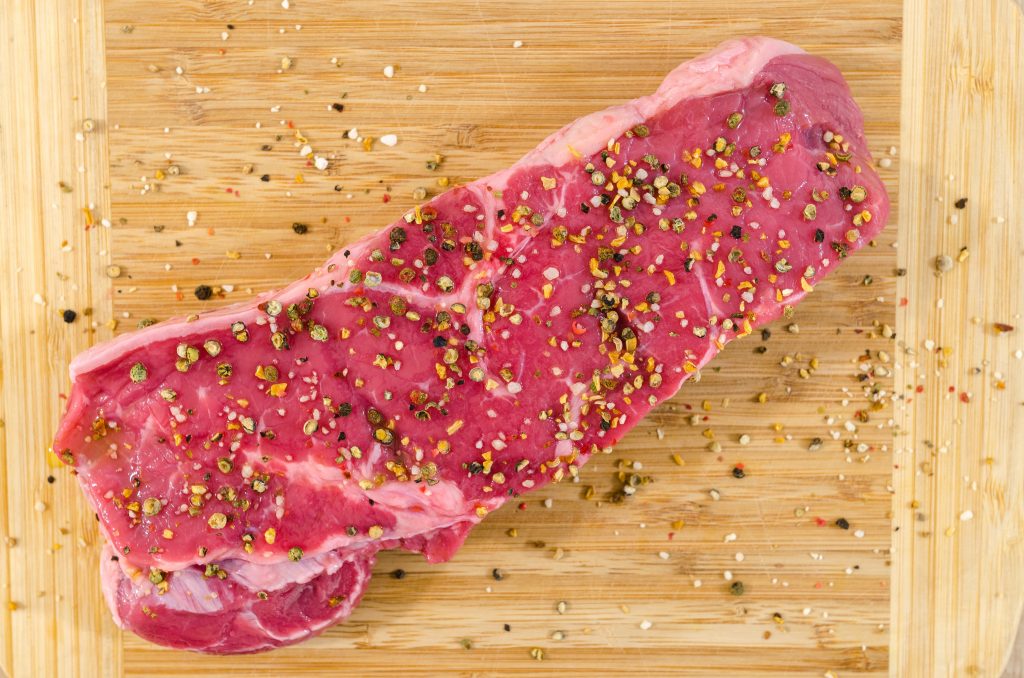
Bavette VS Hanger Steak
Bavette steak and hanger steak are two cuts of beef that are often compared due to their similarities in texture and flavor. Both cuts are known for their rich, beefy taste and are typically cooked using similar methods. However, there are some differences between the two cuts that set them apart.
Hanger steak, also known as butcher’s steak or hanging tender, comes from the diaphragm muscle of the cow and is located near the kidneys. It has a unique shape, resembling a “hanging” piece of meat, and is known for its pronounced grain pattern and tenderness. Hanger steak has a deep, robust flavor that is often described as “meaty” or “umami,” and is typically cooked to medium-rare or medium to ensure optimal tenderness.
On the other hand, Bavette steak comes from the bottom sirloin primal, specifically the flank or abdominal muscles of the cow, as mentioned earlier. It is slightly thicker and wider compared to hanger steak and has a distinct grainy texture that runs along its length. Bavette steak has a rich, beefy flavor that is often compared to hanger steak, but it is usually considered slightly less tender. However, with proper cooking techniques, Bavette steak can still be very tender and flavorful.
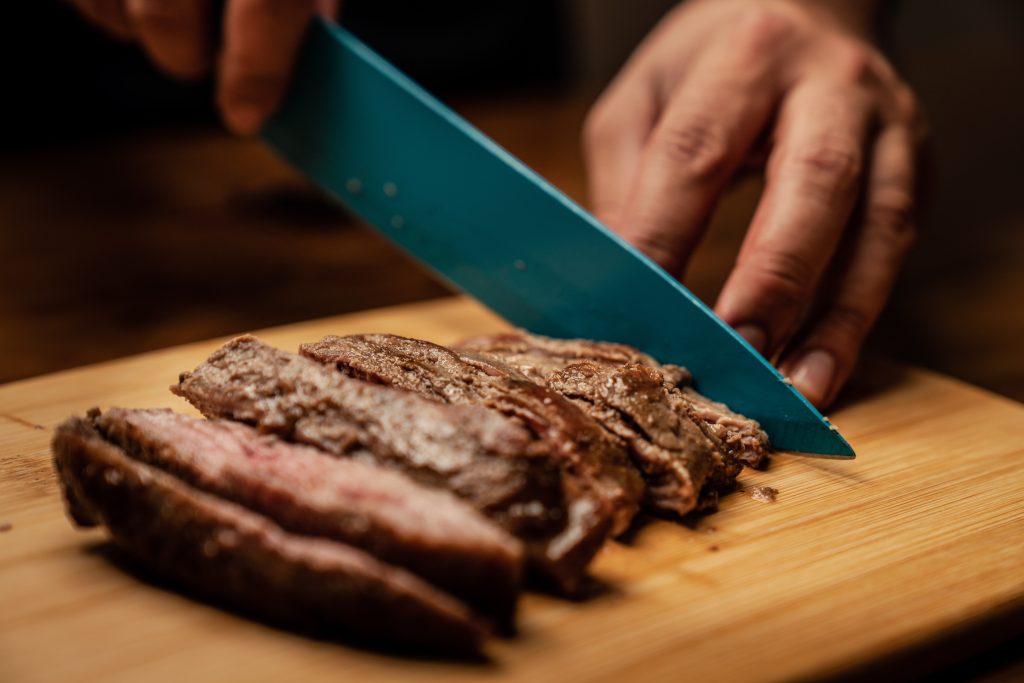
Cooking Methods Of Bavette Steak And Hanger Steak
In terms of cooking methods, both Bavette steak and hanger steak can be prepared using similar techniques. One popular method for cooking Bavette steak is grilling, which helps to bring out its natural flavors and create a nice crust on the outside. To grill Bavette steak, preheat your grill to high heat and season the steak with salt, pepper, and any other desired seasonings. Place the steak on the hot grill and cook for about 4-5 minutes per side for medium-rare, or until the internal temperature reaches around 130°F (54°C) for a slightly more well-done steak. Let the steak rest for a few minutes before slicing it against the grain to serve.
Another popular method for cooking Bavette steak is pan-searing, which can be done in a cast iron skillet or a heavy-bottomed pan. To pan-sear Bavette steak, heat the pan over high heat and add some oil or butter. Season the steak with salt, pepper, and other desired seasonings, and then place it in the hot pan. Cook for about 3-4 minutes per side for medium-rare, or until the internal temperature reaches around 130°F (54°C). Let the steak rest for a few minutes before slicing and serving.
It’s important to note that Bavette steak is relatively thin compared to other cuts of beef, so it cooks quickly and can easily become overcooked. Therefore, it’s crucial to keep a close eye on the cooking time and temperature to ensure that it doesn’t dry out or become tough. Using a meat thermometer to check the internal temperature is a great way to ensure that you achieve the desired level of doneness.
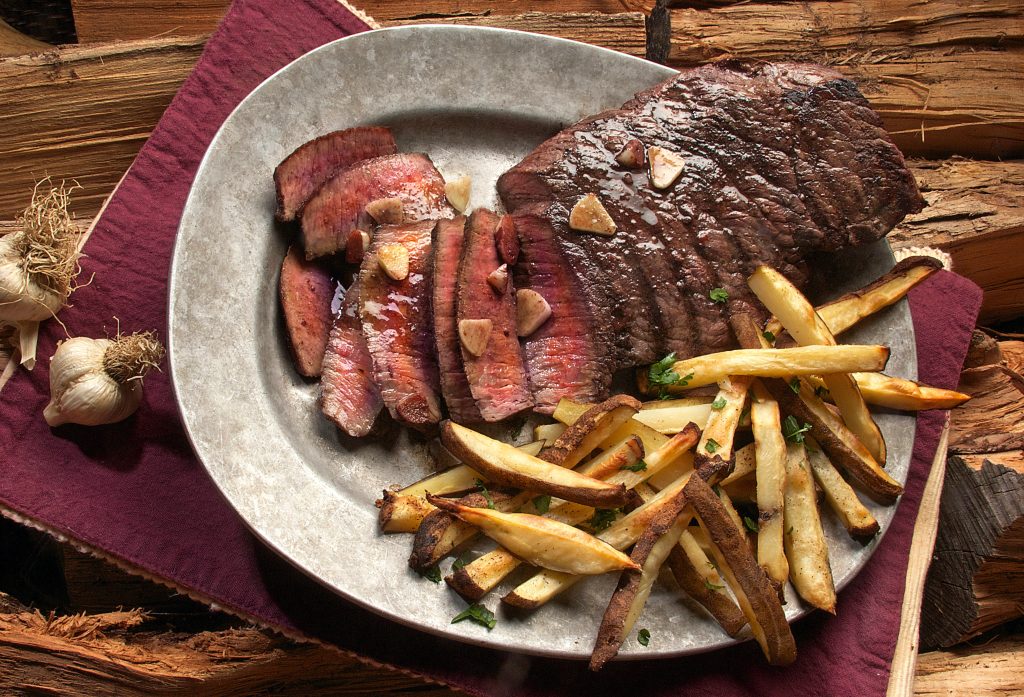
How To Cook Beef Bavette Steak?
Cooking beef Bavette steak can be a simple and rewarding process if done correctly. Here’s a step-by-step guide on how to cook beef Bavette steak:
Step 1: Prepare the Steak – Take the Bavette steak out of the refrigerator and let it sit at room temperature for about 30 minutes before cooking. This helps to ensure that the steak cooks evenly. Meanwhile, season the steak with salt, pepper, and any other desired seasonings, such as garlic powder, rosemary, or thyme.
Step 2: Choose Your Cooking Method – Bavette steak can be cooked using various methods, such as grilling, pan-searing, broiling, or sous vide. Choose the method that suits your preference and equipment availability.
Step 3: Cook the Steak – If grilling, preheat your grill to high heat. If pan-searing, heat a cast iron skillet or a heavy-bottomed pan over high heat with some oil or butter. Once hot, add the seasoned Bavette steak and cook for about 4-5 minutes per side for medium-rare, or until the internal temperature reaches around 130°F (54°C). If broiling, preheat your oven’s broiler on high and cook the steak on a broiler pan or a wire rack set over a baking sheet for about 4-5 minutes per side for medium-rare, or until the internal temperature reaches around 130°F (54°C). If using sous vide, vacuum seal the seasoned steak and cook it in a water bath at the desired temperature for several hours, then sear it in a hot pan or on a grill for a few minutes per side to create a crust.
Step 4: Rest the Steak – Once the steak is cooked to your desired level of doneness, remove it from the heat and let it rest for a few minutes. This allows the juices to redistribute and ensures a more flavorful and tender result.
Step 5: Slice and Serve – After resting, slice the Bavette steak against the grain, which helps to break up the muscle fibers and make it more tender. Serve the steak with your favorite side dishes, such as roasted vegetables, mashed potatoes, or a fresh salad. You can also drizzle some sauce or melted butter over the top for added flavor.
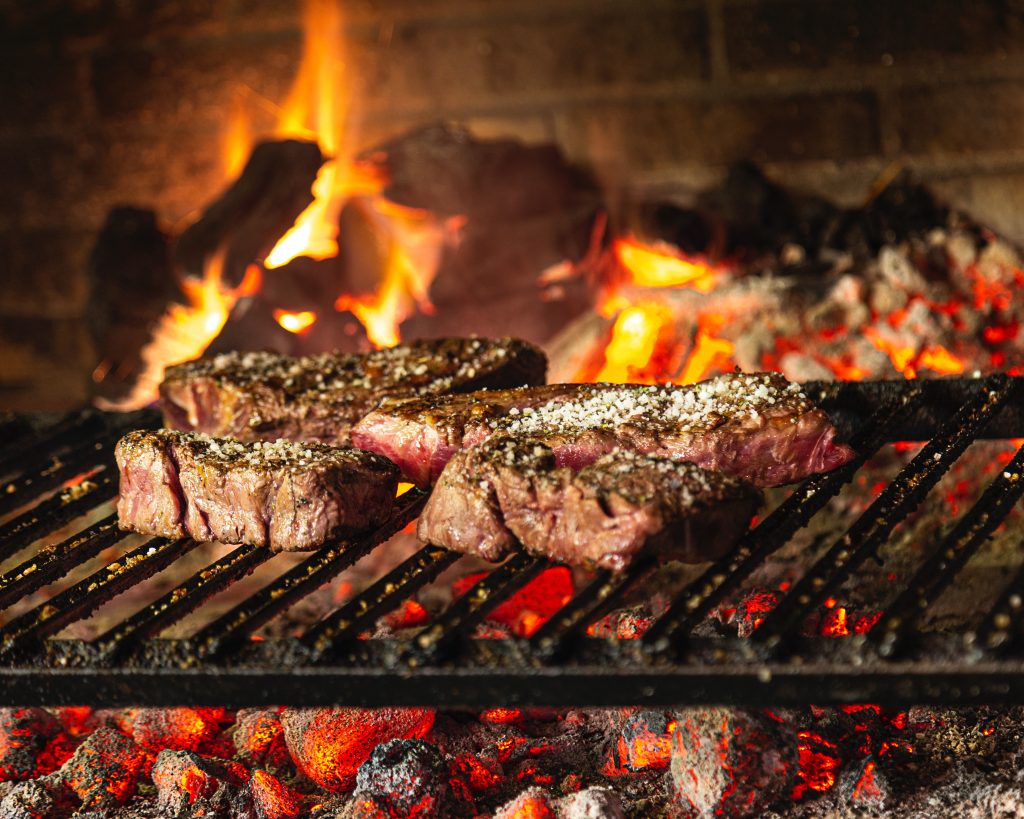
Bavette Steak Cooking Time
As mentioned earlier, Bavette steak is a thin cut of meat that cooks quickly, so it’s important to keep a close eye on the cooking time to avoid overcooking. The cooking time for Bavette steak depends on the method of cooking and the desired level of doneness. Here’s a general guideline for cooking Bavette steak:
Grilling: Cook for about 4-5 minutes per side for medium-rare, or until the internal temperature reaches around 130°F (54°C).
Pan-searing: Cook for about 3-4 minutes per side for medium-rare, or until the internal temperature reaches around 130°F (54°C).
Broiling: Cook for about 4-5 minutes per side for medium-rare, or until the internal temperature reaches around 130°F (54°C).
Sous vide: Cook in a water bath at the desired temperature for several hours, then sear for a few minutes per side to create a crust.
It’s important to note that these are approximate cooking times and the actual time may vary depending on the thickness of the steak, the heat of your cooking equipment, and your desired level of doneness. Using a meat thermometer to check the internal temperature is the most accurate way to determine when your Bavette steak is cooked to perfection.
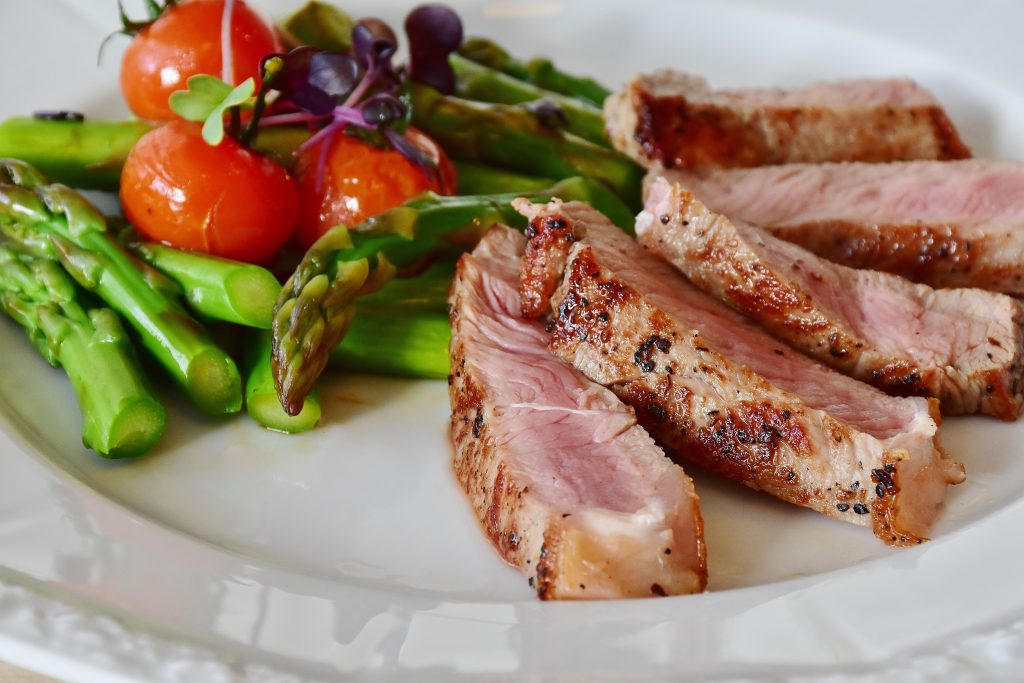
What Cut is a Bavette Steak?
Bavette steak comes from the beef cut known as the flank, which is located in the abdominal area of the cow. The flank is a long, flat muscle that runs along the lower side of the cow’s body and is known for its rich flavor and distinct texture. The Bavette steak specifically comes from the abdominal muscles that are close to the diaphragm, which are known as the flap meat or the sirloin flap. The Bavette steak is also sometimes referred to as the flap steak or the flank steak, although it is slightly different from the traditional flank steak.
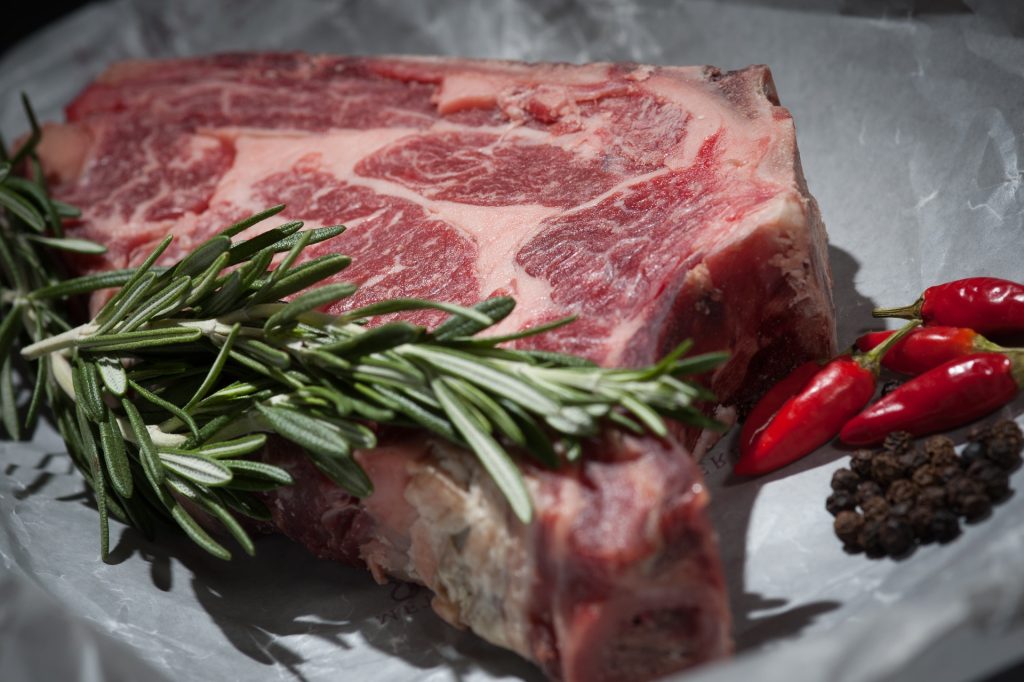
Cuts Of Bavette Steak VS Hanger Steak
Bavette steak and hanger steak are two cuts of beef that are often compared due to their similarities in flavor and texture. Both cuts are known for their rich, beefy flavor and tenderness when cooked properly. However, there are some differences between Bavette steak and hanger steak.
Location: Bavette steak comes from the abdominal muscles close to the diaphragm, while hanger steak comes from the plate, which is located in the lower belly of the cow.
Texture: Bavette steak is known for its loose and open texture, with long muscle fibers that create a distinct grain. Hanger steak, on the other hand, has a more tight and dense texture with shorter muscle fibers.
Flavor: Bavette steak has a rich, beefy flavor with a hint of sweetness, while hanger steak has a stronger, more intense flavor.
Price: Hanger steak is generally considered more expensive than Bavette steak due to its limited availability and higher demand.
In terms of cooking methods, both Bavette steak and hanger steak can be prepared using similar techniques such as grilling, pan-searing, or broiling. However, due to their differences in texture and thickness, the cooking time and temperature may vary slightly. It’s important to follow proper cooking guidelines and use a meat thermometer to ensure that both cuts are cooked to the desired level of doneness.
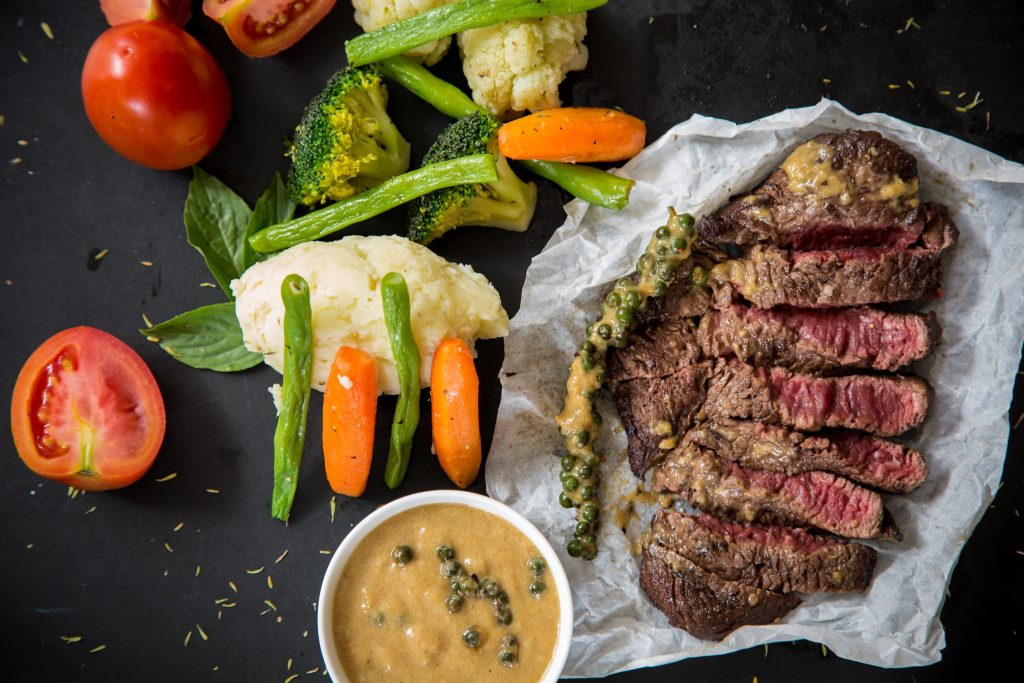
Flank Steak VS Bavette Steak
Flank steak is another cut of beef that is often compared to Bavette steak due to its similar location and texture. Flank steak comes from the same abdominal muscles as Bavette steak, but it is cut from a different part of the flank. Here are some key differences between flank steak and Bavette steak:
Thickness: Flank steak is usually thicker than Bavette steak, which means it may require a longer cooking time to achieve the desired level of doneness.
Grain: Flank steak has a tighter grain compared to Bavette steak, which means it can be slightly tougher if not cooked properly.
Flavor: Flank steak has a bold, robust flavor with a pronounced beefy taste, while Bavette steak has a slightly sweeter flavor profile.
Price: Flank steak is generally more affordable compared to Bavette steak, as it is a larger cut of meat and more readily available.
When it comes to cooking methods, flank steak and Bavette steak can be cooked in similar ways, such as grilling, pan-searing, or broiling. However, due to the differences in thickness and grain, the cooking time and temperature may vary. It’s important to properly marinate flank steak or use a meat tenderizer to help break down the tough fibers and ensure a tender result. Bavette steak, on the other hand, can be cooked to a medium-rare or medium doneness to retain its natural tenderness and flavor.
Is Bavette Steak Expensive?
Compared to other cuts of beef, Bavette steak is generally considered to be more affordable. While prices may vary depending on location, supplier, and other factors, Bavette steak is often priced lower than premium cuts such as ribeye or filet mignon. This makes it a more budget-friendly option for steak lovers who still want to enjoy a flavorful and tender cut of meat without breaking the bank.
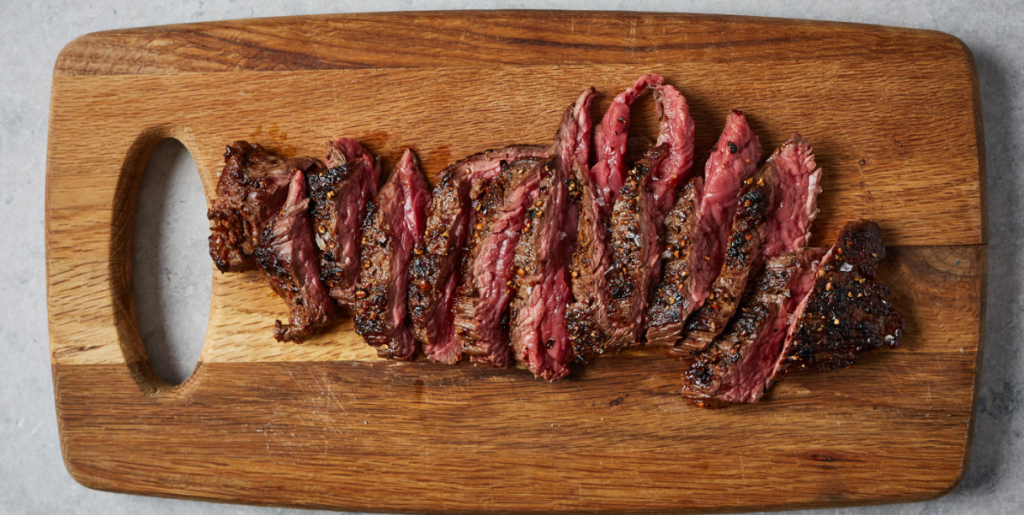
How to Cut Bavette Steak?
Bavette steak is typically sold as a whole piece, and it’s important to know how to properly cut it for cooking. Here’s a step-by-step guide on how to cut Bavette steak:
Place the Bavette steak on a clean cutting board and locate the grain, which refers to the direction in which the muscle fibers run. The grain of Bavette steak is usually visible as long lines or striations on the surface of the meat.
Using a sharp knife, cut against the grain by slicing the meat perpendicular to the direction of the grain. This helps to shorten the muscle fibers and results in a more tender steak.
Cut the Bavette steak into individual portions of your desired thickness. Keep in mind that Bavette steak is a thin cut of meat, so it’s important to cut evenly to ensure even cooking.
Trim any excess fat or connective tissue from the Bavette steak, if desired.
By cutting Bavette steak against the grain, you can help ensure a more tender and enjoyable eating experience.

Is Bavette Steak Good?
Yes, Bavette steak is considered to be a delicious and flavorful cut of meat. It is known for its rich, beefy flavor and tender texture when cooked properly. Bavette steak is often used in various culinary applications, from simple grilling or pan-searing to more elaborate recipes. Its loose grain and open texture make it ideal for marinating, which allows the flavors to penetrate the meat and create a delicious and juicy result.
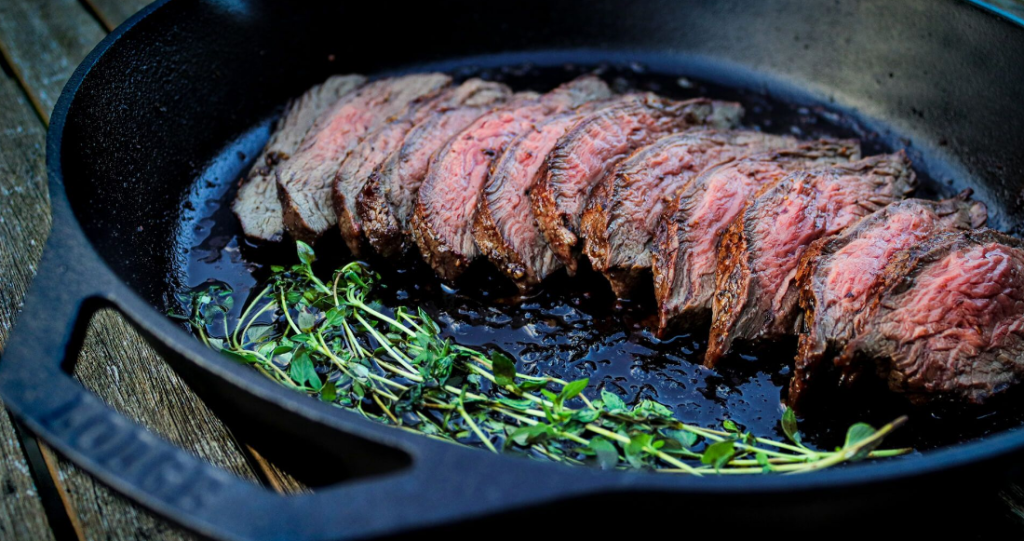
Bavette Steak Recipe Cast Iron
Cooking Bavette steak in a cast iron skillet can be a great way to achieve a delicious and perfectly seared crust while locking in the natural juices of the meat. Here’s a simple recipe for cooking Bavette steak in a cast iron skillet:
Ingredients:
Bavette steak, approximately 1-1.5 lbs
Salt and pepper, to taste
Olive oil or melted butter, for cooking
Fresh herbs, such as thyme or rosemary (optional)
Instructions:
Take the Bavette steak out of the refrigerator and let it come to room temperature for about 30 minutes before cooking. This helps the steak cook more evenly.
Season the Bavette steak generously with salt and pepper on both sides. You can also add some fresh herbs, such as thyme or rosemary, for added flavor.
Heat a cast iron skillet over medium-high heat and add a drizzle of olive oil or melted butter to the pan. Allow it to get hot but not smoking.
Carefully place the seasoned Bavette steak in the hot skillet and let it sear for about 4-5 minutes on each side for medium-rare, or until it reaches your desired level of doneness. Avoid moving the steak too much to allow a crust to form.
Use a meat thermometer to check the internal temperature of the steak. For medium-rare, the internal temperature should be around 130°F (54°C), and for medium, it should be around 135°F (57°C).
Once the Bavette steak reaches the desired temperature, remove it from the skillet and let it rest for a few minutes to allow the juices to redistribute.
Slice the Bavette steak against the grain into thin slices, and serve it with your favorite sides or sauces.
Cooking Bavette steak in a cast iron skillet can result in a flavorful, juicy, and perfectly seared steak that is sure to impress your taste buds.
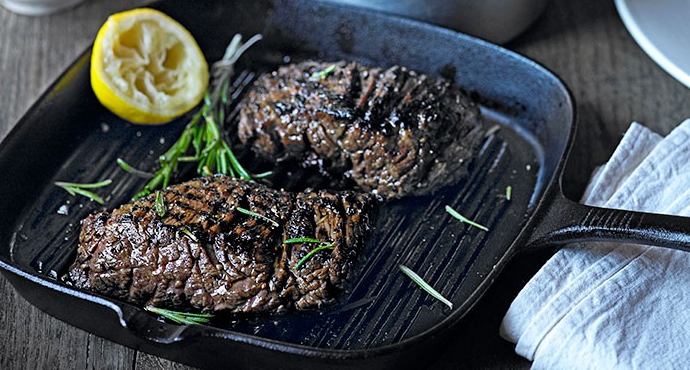
Conclusion
In conclusion, Bavette steak is a delicious and flavorful cut of beef that is gaining popularity among steak lovers for its unique taste and tenderness. It is a thin, flat cut of meat that is rich in flavor and can be cooked using various methods, such as grilling, pan-searing, or broiling. Bavette steak is often compared to other cuts of beef, such as hanger steak and flank steak, but it has its own distinct characteristics in terms of flavor, tenderness, and price.
When cooking Bavette steak, it’s important to properly season it, let it come to room temperature before cooking, and pay attention to the cooking time and temperature to achieve the desired level of doneness. Whether you’re grilling it on a barbecue, searing it in a cast iron skillet, or broiling it in the oven, Bavette steak can be a delicious and versatile option for a satisfying meal.
So, if you’re looking to try a new cut of beef or want to expand your steak repertoire, give Bavette steak a try. With its rich flavor, tenderness, and versatility in cooking methods, it can be a great addition to your culinary repertoire. Happy cooking and bon appétit!


